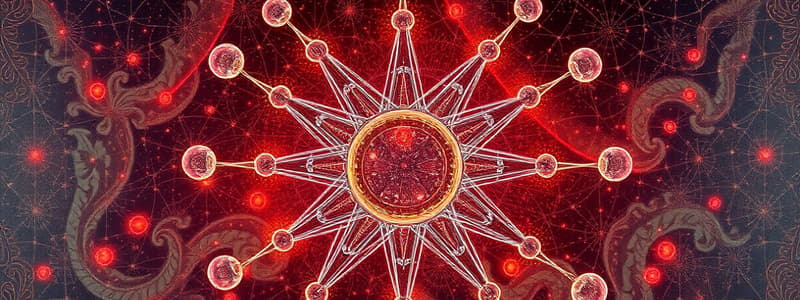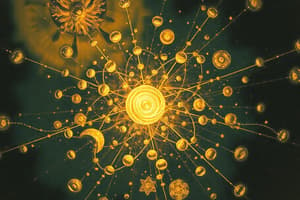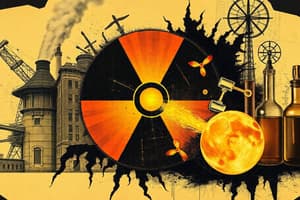Podcast
Questions and Answers
What describes the charge and nature of a neutron?
What describes the charge and nature of a neutron?
- Charge of +1, and exists in the nucleus.
- Charge of 0, and is found surrounding the nucleus.
- Charge of 0, and exists in the nucleus. (correct)
- Charge of -1, and exists outside the nucleus.
What is the nucleon number of an atom defined as?
What is the nucleon number of an atom defined as?
- The number of neutrons in the atom.
- The number of protons only.
- The mass of the electrons in the atom.
- The sum of protons and neutrons. (correct)
Which of the following statements is correct regarding isotopes?
Which of the following statements is correct regarding isotopes?
- Isotopes have different mass numbers. (correct)
- Isotopes have different proton numbers.
- Isotopes are defined by the number of neutrons.
- Isotopes of the same element have the same neutron number.
How is the atomic mass of an element calculated?
How is the atomic mass of an element calculated?
In isotopic notation, what does the superscript represent?
In isotopic notation, what does the superscript represent?
What is the relative isotopic mass of an isotope?
What is the relative isotopic mass of an isotope?
For potassium (K), which statement is true regarding its isotopes?
For potassium (K), which statement is true regarding its isotopes?
What is the charge of beta particles?
What is the charge of beta particles?
Which type of radiation is unaffected by an electric field?
Which type of radiation is unaffected by an electric field?
When balancing a nuclear equation, which of the following must be conserved?
When balancing a nuclear equation, which of the following must be conserved?
How is an alpha particle represented in nuclear equations?
How is an alpha particle represented in nuclear equations?
What is the penetration ability of alpha particles in air?
What is the penetration ability of alpha particles in air?
What is the atomic mass of potassium?
What is the atomic mass of potassium?
In finding the percentage of 20Ne in the isotopic mixture, what percentage of 22Ne is present when 20Ne is 90%?
In finding the percentage of 20Ne in the isotopic mixture, what percentage of 22Ne is present when 20Ne is 90%?
Which isotopes make up the normal isotropic mixture of gallium (Ga)?
Which isotopes make up the normal isotropic mixture of gallium (Ga)?
Which type of nuclear reaction involves the collision of two atomic nuclei to form a new nucleus?
Which type of nuclear reaction involves the collision of two atomic nuclei to form a new nucleus?
What is the relative atomic mass of Ne if it consists of 20Ne and 22Ne?
What is the relative atomic mass of Ne if it consists of 20Ne and 22Ne?
If 6Li accounts for 7.4% of the isotropic mixture, what percentage does 7Li account for?
If 6Li accounts for 7.4% of the isotropic mixture, what percentage does 7Li account for?
Which of the following is NOT a type of radiation emitted in nuclear reactions?
Which of the following is NOT a type of radiation emitted in nuclear reactions?
What is the role of fission nuclear reactions?
What is the role of fission nuclear reactions?
How do you calculate the atomic mass when given the percentages of isotopes?
How do you calculate the atomic mass when given the percentages of isotopes?
Which isotope has a higher mass, 20Ne or 22Ne?
Which isotope has a higher mass, 20Ne or 22Ne?
Flashcards
Atom
Atom
The smallest particle in an element, consisting of a nucleus surrounded by negatively charged electrons.
Nucleus
Nucleus
The central part of an atom, composed of protons and neutrons.
Neutron
Neutron
A particle found in the nucleus with a neutral charge.
Proton
Proton
Signup and view all the flashcards
Nuclide
Nuclide
Signup and view all the flashcards
Atomic number (Z)
Atomic number (Z)
Signup and view all the flashcards
Isotopes
Isotopes
Signup and view all the flashcards
What are alpha particles?
What are alpha particles?
Signup and view all the flashcards
What are beta particles?
What are beta particles?
Signup and view all the flashcards
What are gamma rays?
What are gamma rays?
Signup and view all the flashcards
How to balance nuclear equations?
How to balance nuclear equations?
Signup and view all the flashcards
What are the charges of alpha, beta, and gamma particles?
What are the charges of alpha, beta, and gamma particles?
Signup and view all the flashcards
Atomic Mass
Atomic Mass
Signup and view all the flashcards
Isotopic Abundance
Isotopic Abundance
Signup and view all the flashcards
Fusion
Fusion
Signup and view all the flashcards
Fission
Fission
Signup and view all the flashcards
Alpha Particle (α)
Alpha Particle (α)
Signup and view all the flashcards
Beta Particle (β)
Beta Particle (β)
Signup and view all the flashcards
Gamma Radiation (γ)
Gamma Radiation (γ)
Signup and view all the flashcards
Radioactive Decay
Radioactive Decay
Signup and view all the flashcards
Half-life
Half-life
Signup and view all the flashcards
Study Notes
The Atom
- Atoms are the smallest particles of an element
- Atoms consist of a nucleus surrounded by electrons
- The nucleus contains protons and neutrons
- A proton has a positive charge (+1)
- A neutron has no charge (0)
- An electron has a negative charge (-1)
- Protons and neutrons can exist independently
- A nuclide is an atomic species with known proton and neutron numbers
- Atomic number (Z) is equal to the number of protons (and electrons)
- Nucleon number (A) is the sum of protons and neutrons (also called mass number)
- Isotopes are atoms of the same element with the same number of protons but different numbers of neutrons
- Isotopic mass is the mass of an atom of an isotope, expressed in atomic mass units (u)
- The atomic mass of an element is the average of the isotopic masses of its isotopes, weighted by their abundance in nature.
Nuclear Reactions
- Fusion occurs when two atomic nuclei collide and fuse to form a new nucleus
- Fission occurs when a heavy nucleus splits into lighter nuclei
- Alpha particles (α) are positively charged (He-4) particles
- Beta particles (β) are negatively charged electrons produced by radioactive decay
- Gamma rays (γ) are high-energy electromagnetic radiation with no charge
- Nuclear reactions involve changes in the nucleus of an atom
Balancing Nuclear Equations
- Mass number and atomic number must be equal on both sides of a nuclear equation
- Different particles like alpha particles, beta particles, protons, and neutrons are used in nuclear reactions.
Half-Life and Activity
- Activity of a radioactive substance is the number of disintegrations per unit time
- Half-life is the time it takes for half of a radioactive substance to decay
Studying That Suits You
Use AI to generate personalized quizzes and flashcards to suit your learning preferences.




